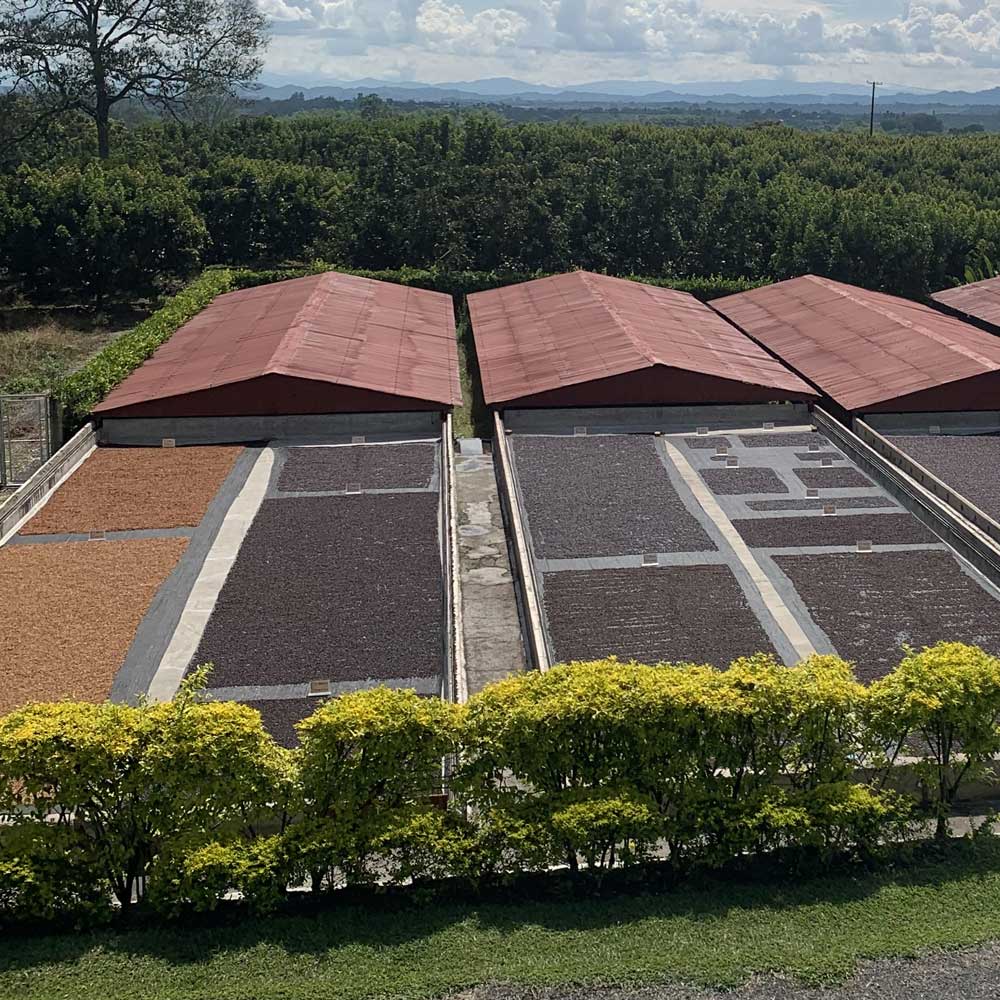
Coffee production is described in a number of ways that work to describe the process of fermentation the coffee has undergone and the type of flavours we can expect in the cup. But before talking about processing methods, let's talk about the green bean. Coffee, when grown resembles a cherry and in fact is often referred to as a ‘coffee cherry’ it has a fleshy outer layer of mucilage often a deep red in colour with the coffee bean sitting like a seed in the centre of the cherry.
The cherries are left to ripen on the tree to develop sugars within the fruit. Once picked the coffee then undergoes a process of fermentation, which is what we refer to as the processing methods. Depending on the processing method the mucilage of the coffee cherry may be removed completely, left on the cherry or somewhere in between.
WASHED PROCESS
The most widely used processing technique, coffee cherries undergoing the washed process will have the outer skin of the cherry removed and then are put in large fermentation tanks. There are two variations on this method, the first being the 'dry' method, where the cherries are left in the fermentation tanks and the second ‘wet method’, where the tanks are filled with water and left to ferment.
Both methods the cherry is left to ferment in the tanks until the coffee bean is easily removed from the mucilage, this usually takes between 12-18 hours. Then the beans are washed to remove all loose mucilage and layed out to dry on drying beds.
Washed coffees are known for their well balanced, complex and floral aromas. Wet process coffees tend to be cleaner in their flavours, with dry process coffees giving a little more sweetness and body.
NATURAL PROCESS
Natural processing is the oldest and arguably the simplest method. Coffee cherries are picked and layed out on raised dying beds to dry naturally in the sun with the whole cherry intact. There are a few nuances to this but this basically it. Once the coffee cherries are dry the fruit layer is removed from the bean.
SEMI-NAT/ HONEY WASHED/ PULP NATURAL
Semi Natural, Honey Washed and Pulp Natural processes are kind of an intermediary between Washed and Natural processing. The three methods are all slightly different but in basic terms in these processes the outer layer of the coffee cherry is stripped back, leaving some of the fruit and mucilage on the bean. The coffee is then piled thickly onto the drying beds and left to ferment. Once fermentation is complete the coffee is then raked out thinly on the beds and left to dry.
ANAEROBIC FERMENTATION
Anaerobic fermentation is a blanket term that is used to describe coffee that is fermented in an oxygen free environment. These methods of fermentation using an anaerobic process were developed by working with wine producers to create a science led approach to fermenting coffee. One example of this type of fermentation is carbonic maceration, in this process the coffee is fermented inside of temperature and humidity controlled tanks that are flushed with carbon dioxide to ensure tanks are devoid of oxygen. After fermentation the coffee is then left to rest on drying beds.
Our aim at Grouch & Co is to get customers invested in specialty coffee. This is why people come to us over the countless other coffee shops in the area and why they would come to us to buy retail coffee. When customers ask for information on coffee we want our staff to be able to chat their ear off about it, and use it as an opportunity to convert another person to loving good coffee.COUNTRY OF ORIGIN/ ALTITUDE
One of the main descriptors we use to identify different single origin coffees is the country of origin. Coffees from different countries and regions have distinct flavour profiles due to a number of factors such as altitude, varietals, soil quality, climate and processing methods. Growing regions can be grouped into 3 growing regions: Africa, America and Asia.
Notable African growing regions:
Kenya: Kenyan coffees are grown at high altitudes in rich volcanic soils. They are known for their bright acidity and complex flavours containing berry, citrus and with some bolder wine flavors.
Ethiopia: The oldest growing region in the world, Ethiopian coffee varietals are often listed as heirloom as often the varietal is unknown. You can expect big blueberry and strawberry flavors from natural processed coffee and delicate floral flavors of jasmine from washed process coffee.
Notable American growing regions:
Central America: Costa Rica, Guatemala, Honduras, El Salvador, Panama
South America: Colombia, Brazil, Ecuador
The largest coffee producing regions in the world these coffees and contribute big bold chocolate, caramel and maple syrup flavors, and are often the foundation of coffee blends for use with milk.
Asian growing regions:
India: Indian coffees are spicy and full bodied often with quite savory flavour profiles.
Indonesia: Indonesia is home to so many notable growing regions including Samatarian and PNG coffees. Indonesia usually processes their coffee using the wet hull method giving their coffee a unique body and earthiness.
Altitude
We often list the altitude on our coffee bags as a way of referencing the quality of the coffee. We tend to think of a higher altitude being indicative of a higher quality coffee. Coffee grown at higher altitudes ripens slower than at lower altitudes, and allows for full development of sugars within the fruit and increased density within the coffee bean. This leads to greater flavour development in the roasted bean.

